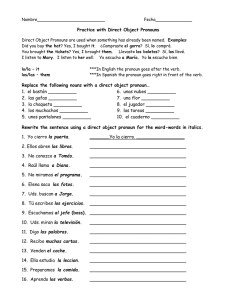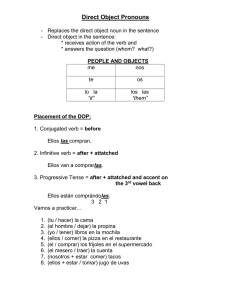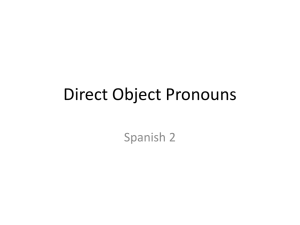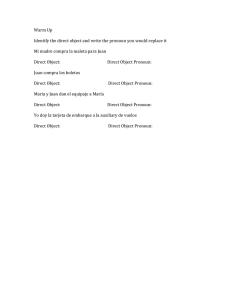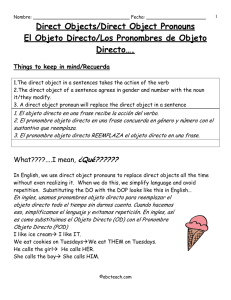Direct object pronouns (p. 138) lo lo
Anuncio
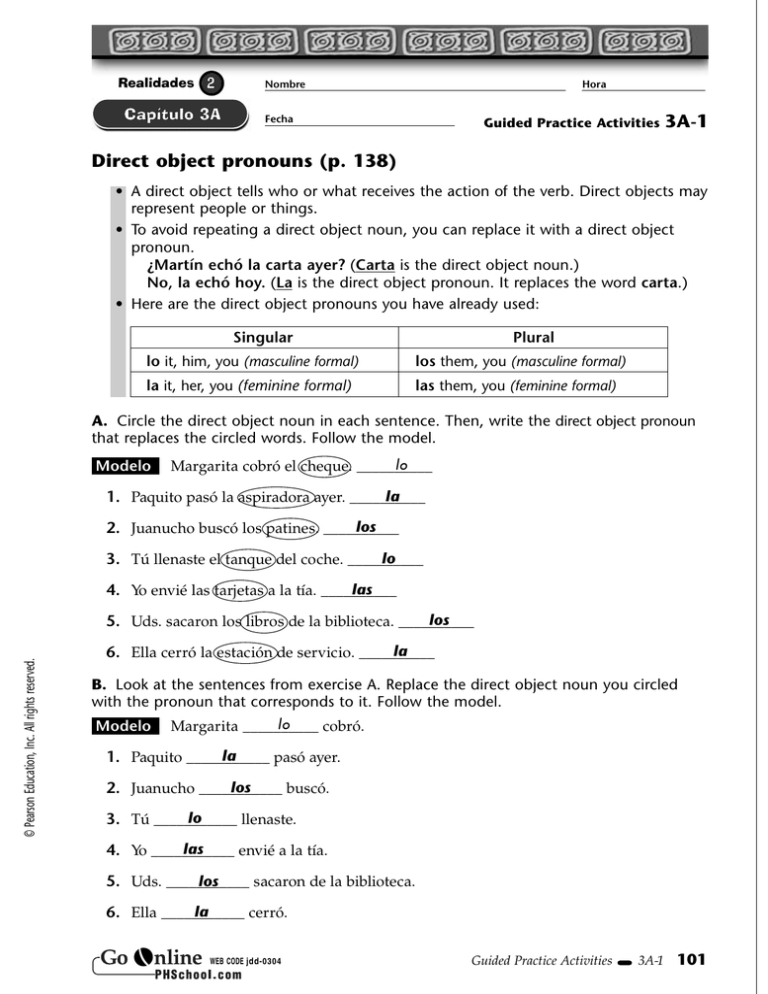
Realidades Nombre Hora Fecha Guided Practice Activities 3A-1 Direct object pronouns (p. 138) • A direct object tells who or what receives the action of the verb. Direct objects may represent people or things. • To avoid repeating a direct object noun, you can replace it with a direct object pronoun. ¿Martín echó la carta ayer? (Carta is the direct object noun.) No, la echó hoy. (La is the direct object pronoun. It replaces the word carta.) • Here are the direct object pronouns you have already used: Singular Plural lo it, him, you (masculine formal) los them, you (masculine formal) la it, her, you (feminine formal) las them, you (feminine formal) A. Circle the direct object noun in each sentence. Then, write the direct object pronoun that replaces the circled words. Follow the model. Modelo lo Margarita cobró el cheque. __________ la 1. Paquito pasó la aspiradora ayer. __________ los 2. Juanucho buscó los patines. __________ lo 3. Tú llenaste el tanque del coche. __________ las 4. Yo envié las tarjetas a la tía. __________ © Pearson Education, Inc. All rights reserved. los 5. Uds. sacaron los libros de la biblioteca. __________ la 6. Ella cerró la estación de servicio. __________ B. Look at the sentences from exercise A. Replace the direct object noun you circled with the pronoun that corresponds to it. Follow the model. Modelo lo Margarita __________ cobró. la 1. Paquito ___________ pasó ayer. los 2. Juanucho ___________ buscó. lo 3. Tú ___________ llenaste. las 4. Yo ___________ envié a la tía. los 5. Uds. ___________ sacaron de la biblioteca. la 6. Ella ___________ cerró. WEB CODE jdd- 0304 Guided Practice Activities 3A-1 101 Realidades Nombre Fecha Hora Guided Practice Activities 3A-1a Direct object pronouns (continued ) C. Circle the direct object noun in each question. Then, answer each question by using a direct object pronoun in your answer. Use the verbs given. Follow the model. Modelo ¿Él cobró el cheque el martes pasado? lo cobró Sí, _________ _______________ el martes pasado. la pasó 1. ¿Ella pasó la aspiradora ayer? Sí, _________ _______________ ayer. lo arreglaron esta 2. ¿Ellos arreglaron el cuarto esta semana? No, no _________ _______________ semana. la echó 3. ¿Quién echó la carta en el buzón? Anita _________ _______________ en el buzón. las envió 4. ¿Quién envió las tarjetas de cumpleaños? Billy _________ _______________. los sacaron 5. ¿Ellas sacaron los libros de la biblioteca? Sí, _________ _______________ de la bilbioteca. la cerraron 6. ¿Jenny y Miguel cerraron la estación de servicio? No, no _________ _______________. los lavó 7. ¿Él lavó los platos anoche? Sí, _________ _______________ anoche. • The direct object pronoun is placed before conjugated verbs. When an infinitive is present, the pronoun may come before the conjugated verb or attached to the infinitive. Lo tengo que hacer. or Tengo que hacerlo. Modelo ¿La raqueta? La voy a comprar mañana. ________________________________. Voy a comprarla mañana 1. ¿Las cartas? Las vamos a echar hoy. ________________________________. Vamos a echarlas hoy 2. ¿El palo de golf? Lo tengo que comprar. ________________________________. Tengo que comprarlo 3. ¿Los patines? Los vas a usar esta tarde. ________________________________. Vas a usarlos esta tarde 4. ¿La mesa? La voy a poner hoy. ________________________________. Voy a ponerla hoy 5. ¿Los periódicos? Los voy a separar esta noche. ________________________________. Voy a separarlos esta noche 6. ¿El dentista? Lo tengo que visitar hoy. 102 Guided Practice Activities 3A-1a ________________________________. Tengo que visitarlo hoy WEB CODE jdd- 0304 © Pearson Education, Inc. All rights reserved. D. Rewrite the following sentences to show a second possibility for where the direct object pronouns can be placed. Follow the model.
